SEO
7 Easy SEO Tips for Small Businesses
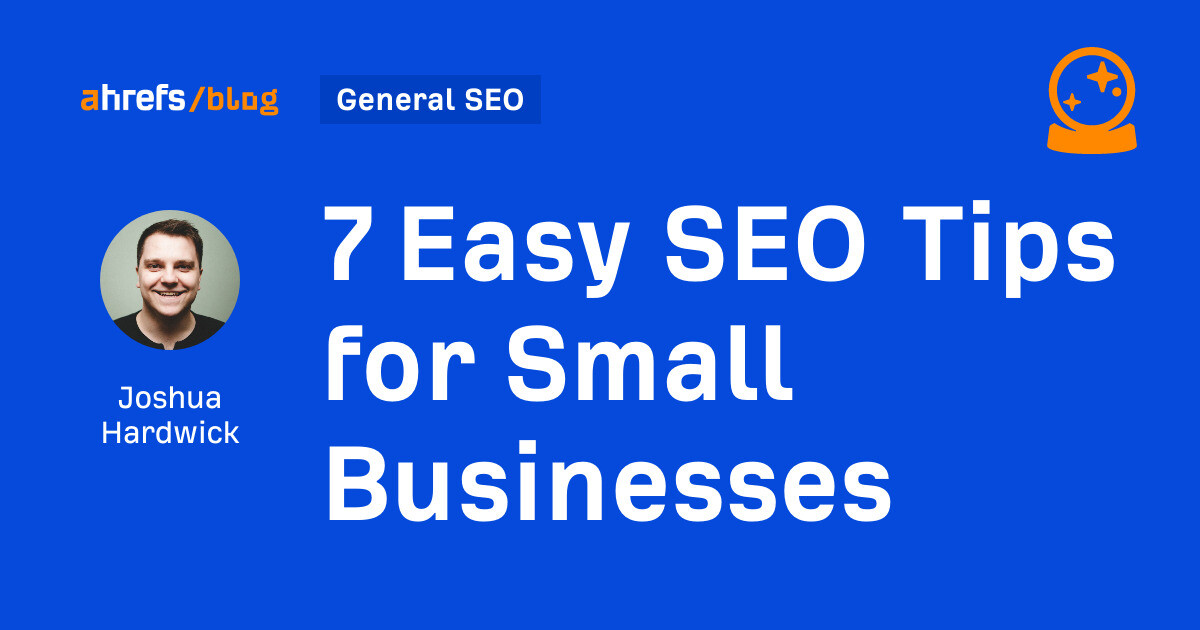
If you’re a small business owner, people are searching for what you do on Google. Unless you show up, you’re missing out on customers or clients.
SEO is how you do that, and the basics are quick and easy.
Follow these tips to rank your small business higher in no time.
If you only do one thing as a small business owner, make it to claim and optimize your GBP.
A Google Business Profile helps users find and learn about your business in Google search and maps. It’s free to set up and lets you share important details about your business with customers, like its phone number, opening times, and offerings.
But here’s the real beauty of Business Profiles: People don’t have to search for your business to see your profile. They can appear for broader searches like “pizza restaurant near me.”
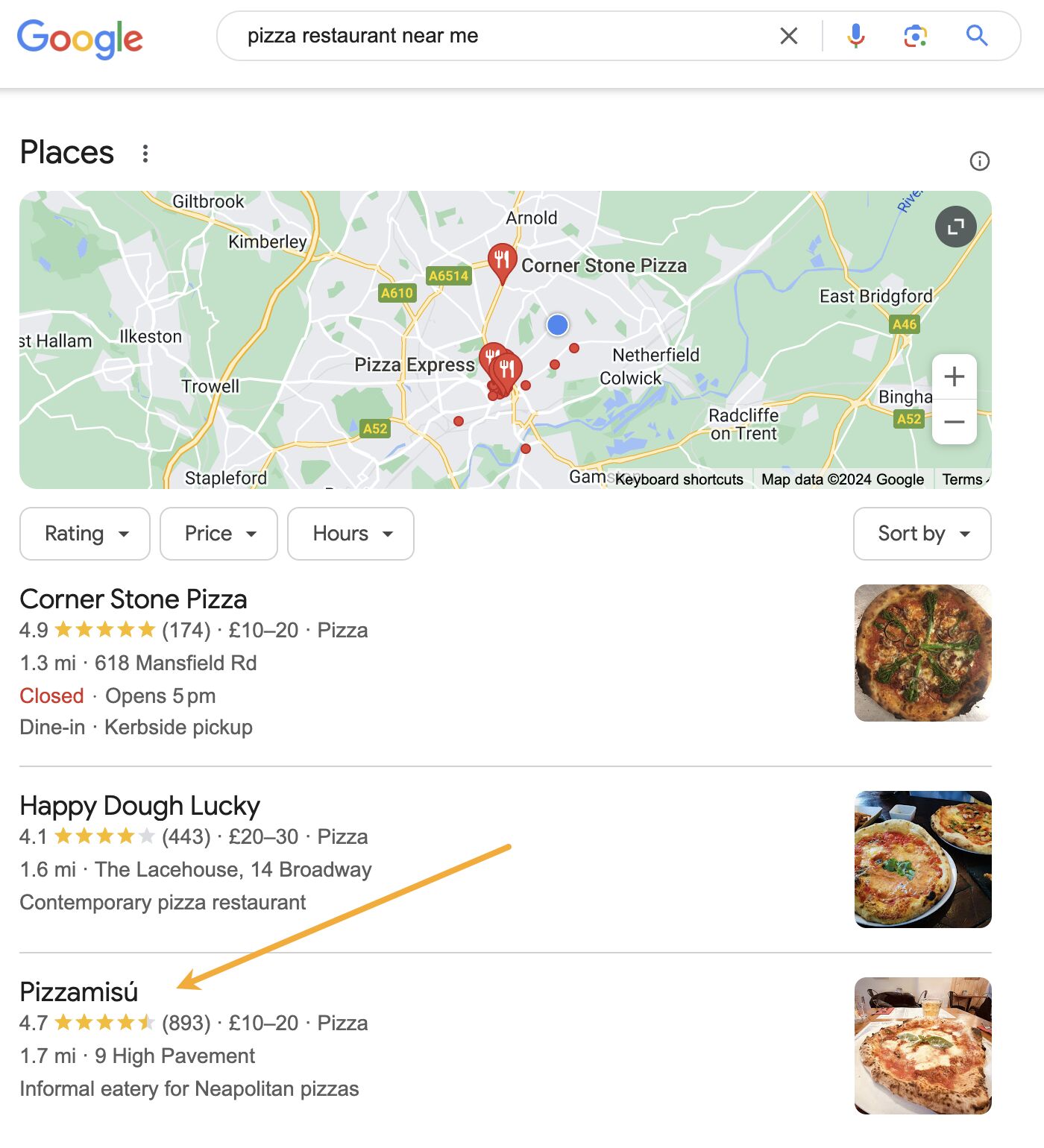

This makes them a powerful way to attract new customers searching for what you do.
Here are the basics of optimizing your profile:
- Set the right business category and type
- Add opening hours (and keep them up to date!)
- Add contact details
- Add photos
- Add your products or services
Learn more in our 30-minute Business Profile optimization guide.
People don’t always turn to Google to find small businesses. They also search popular business directories and trusted review websites.
Even if they do search Google, they’ll often end up browsing a popular directory anyway because that’s often what ranks.
For example, I was recently searching for a cat sitter for an upcoming vacation. I started my search by typing “cat sitter near me” into Google. But I soon ended up browsing a niche directory because that’s what all the top results were.
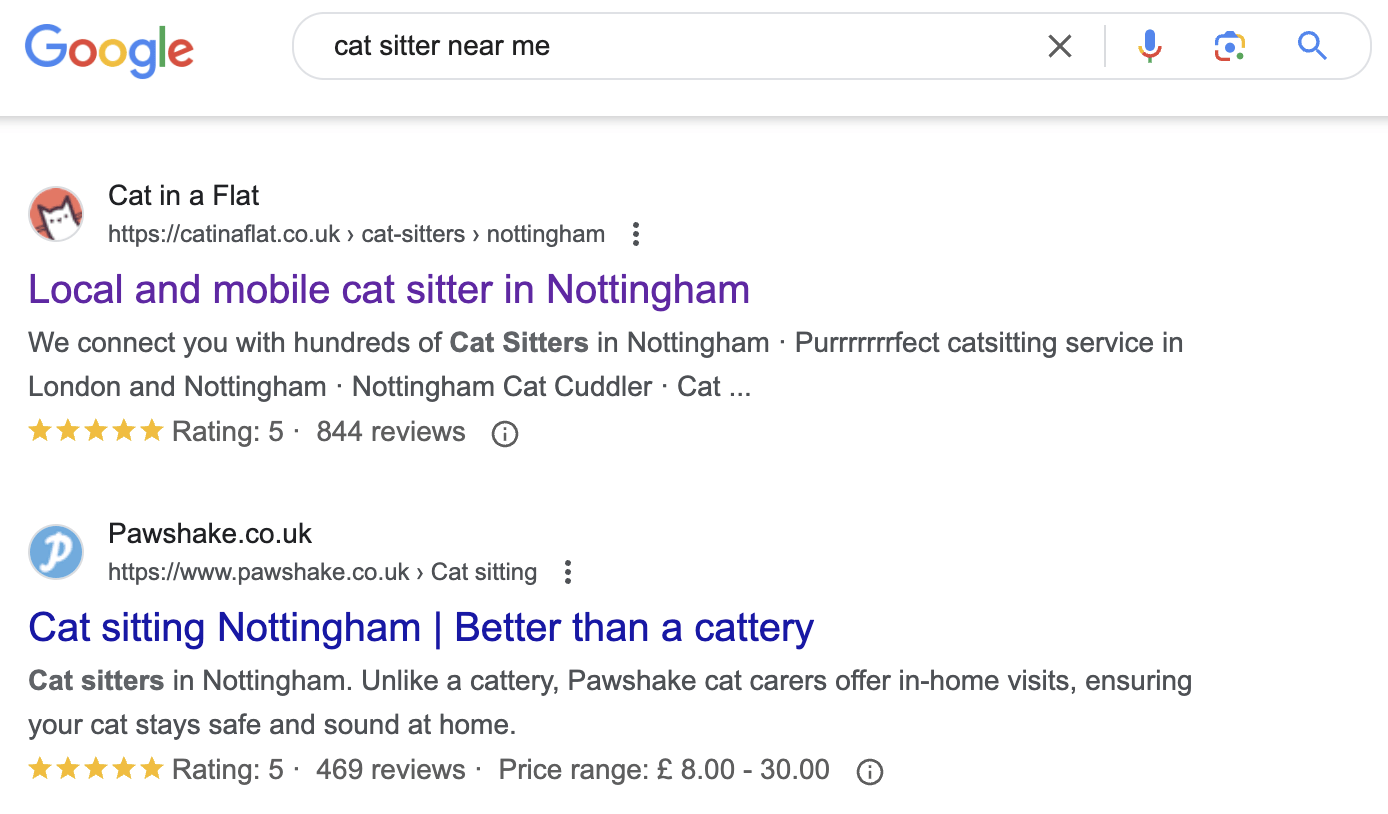

In fact, I even ended up booking a cat sitter through one of these websites:


Long story short, if you’re not listed on popular niche or local directories, you’re losing out on second-hand search traffic and customers.
Let’s look at a couple of ways to find the best directories to get listed on.
Search Google
Head over to Google and search for “[what your business does] in [location]”, then add your business to directories that rank on the first page.
For example, if you’re a cat sitter in Seattle, you’ll probably want to get listed on:
- Meowtel
- Rover.com
- Yelp
- Care.com
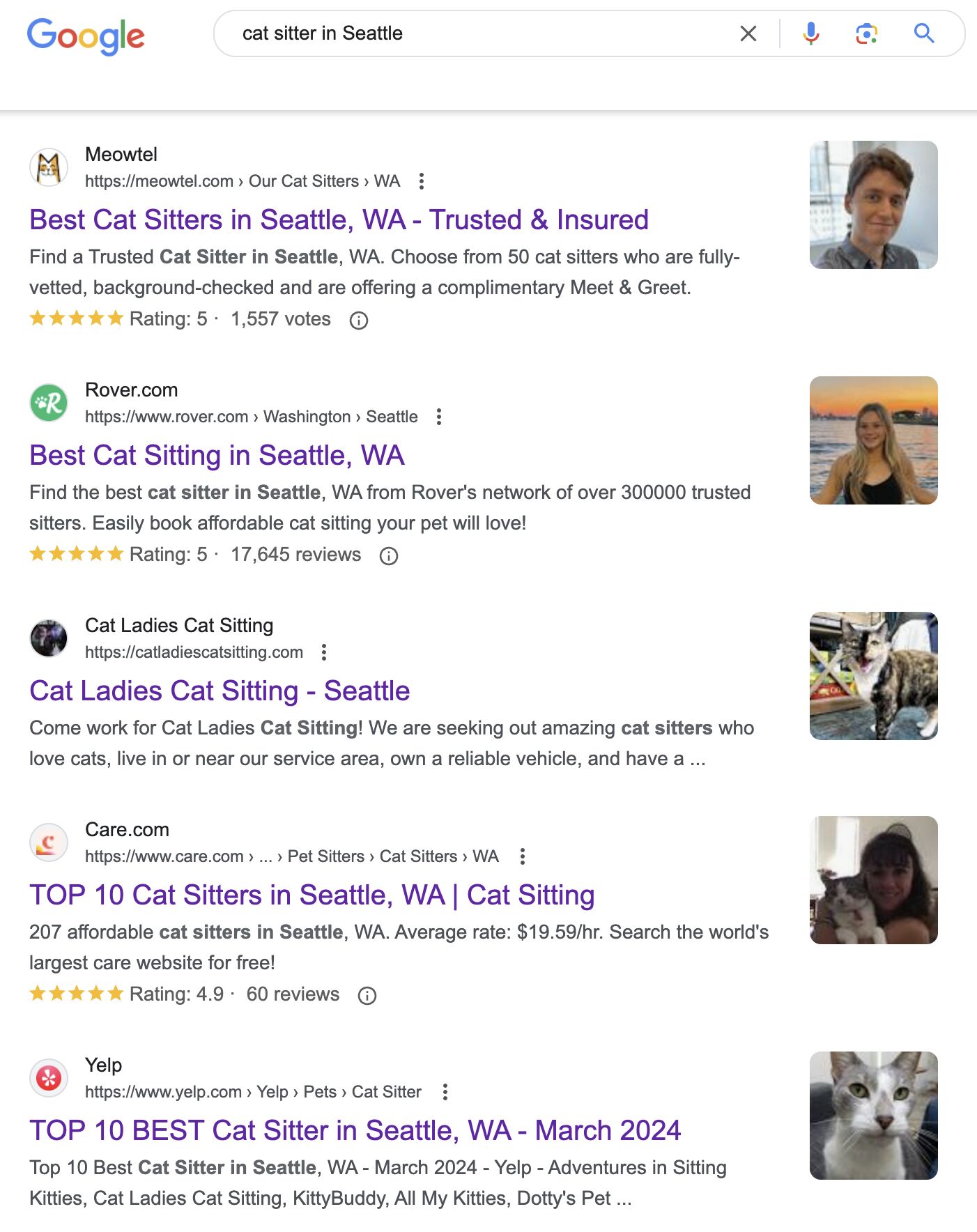

Find the directories your competitors are listed on
Most directory listings also link to your website, which means you can use your competitors’ backlink profile to find relevant directories.
Here’s how to do it in Ahrefs:
- Go to our Competitive Analysis tool
- Select the “referring domains” mode
- Enter your site in the “Not linking to target” field
- Enter the sites of a few competing businesses in the “But linking to these competitors” fields
- Hit “Show link opportunities”
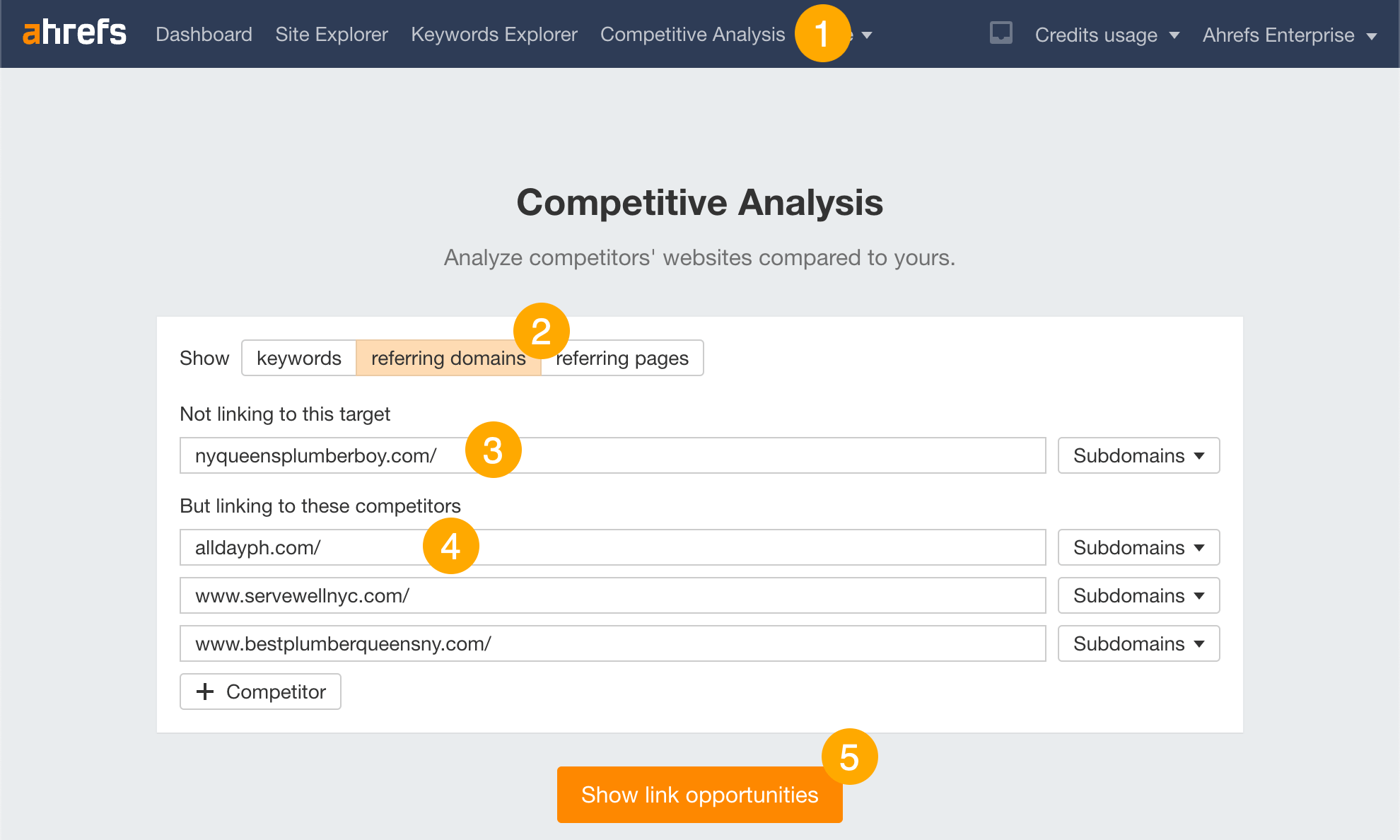

You should see a list of domains that link to your competitors but not you. Eyeball this list for sites that look like relevant directories and add your business to them.
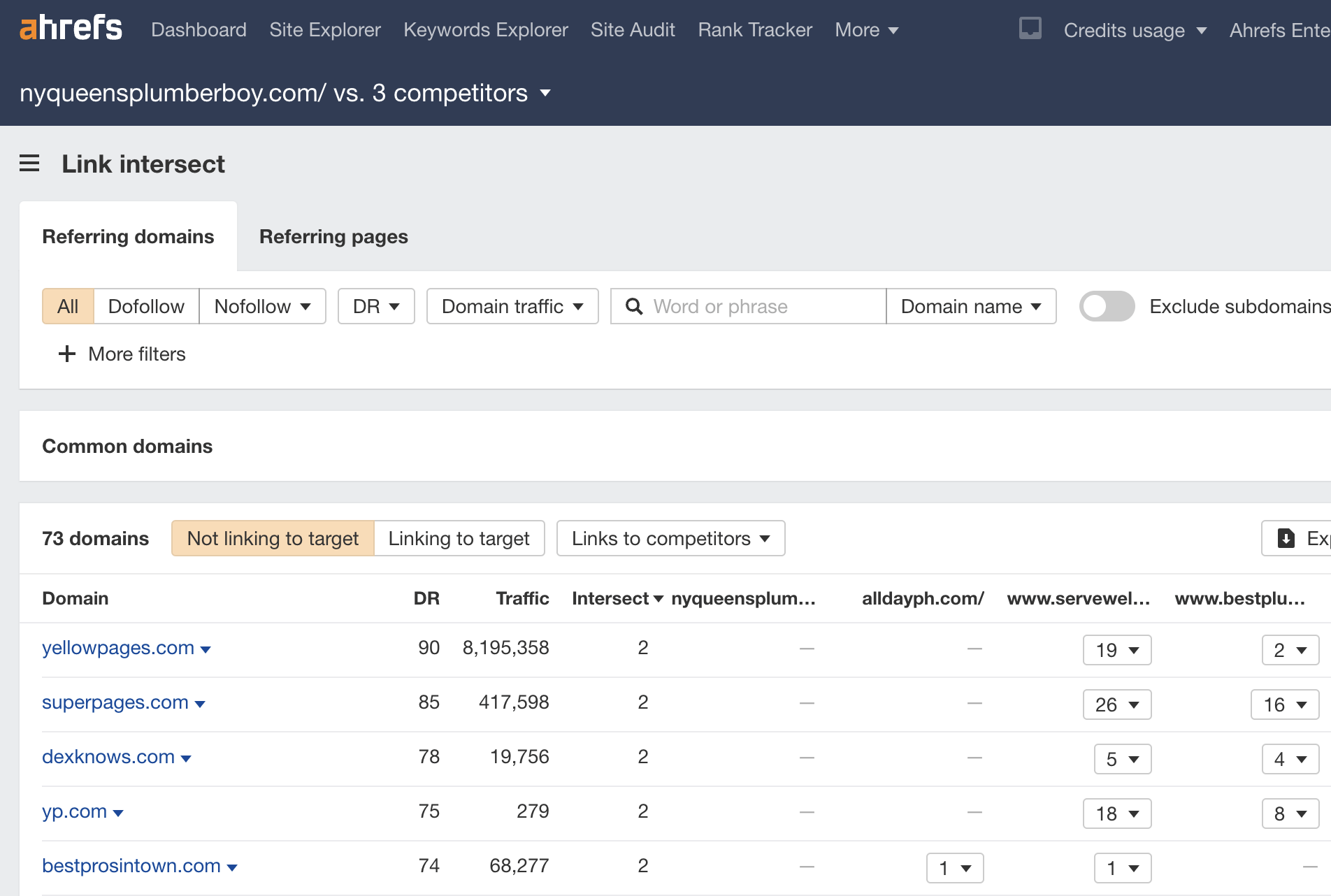

Not sure who your competitors are?
Search Google for “[what your business does] in [location]” and go to Maps. Follow the website links on their profiles to find their domains, then copy and paste them into Ahrefs.
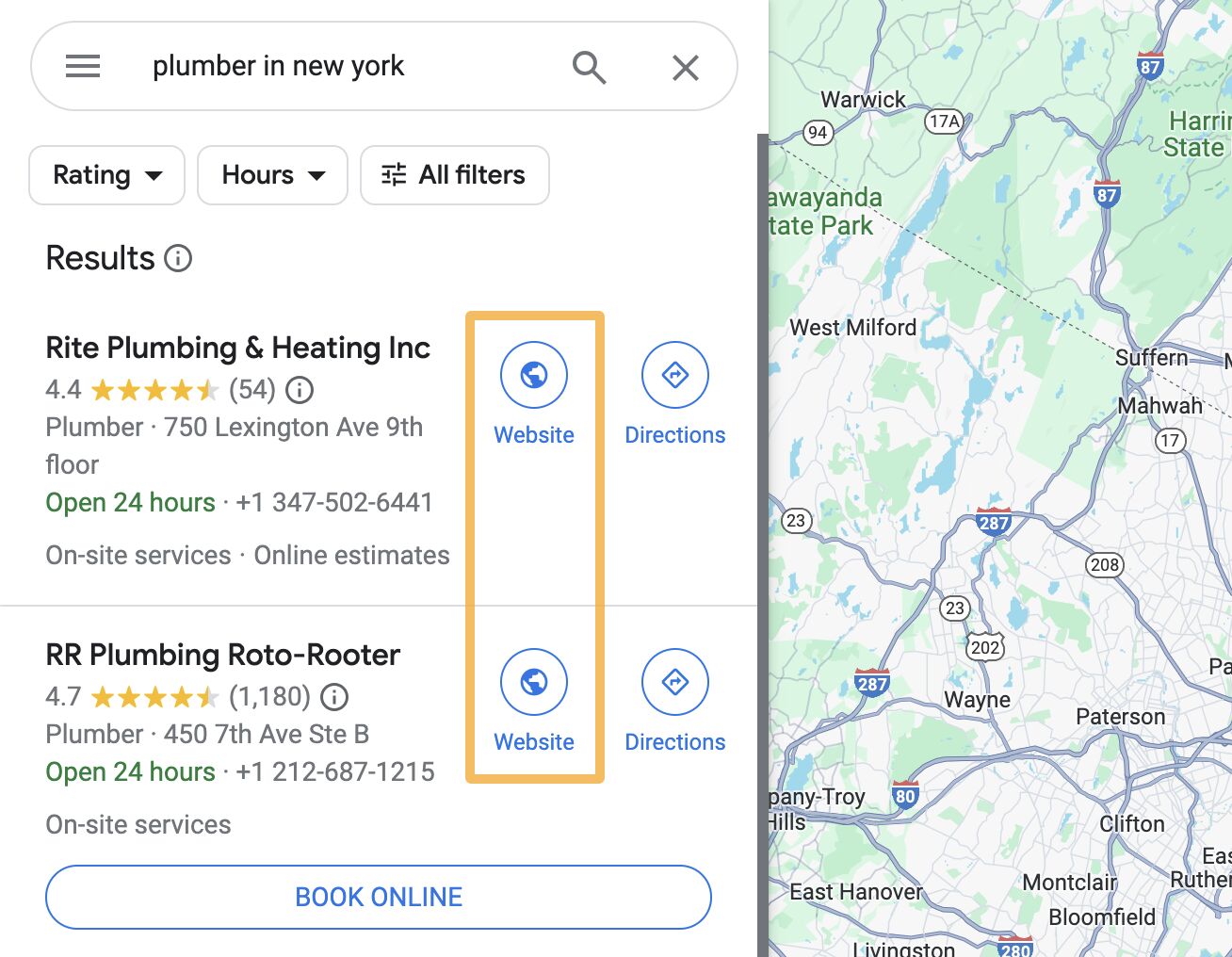

Having technical SEO issues can hurt your rankings, so it’s worth checking that your website is technically sound and fixing any major issues.
The easiest way to do this is with an SEO audit tool like Ahrefs’ Site Audit. You can use this free of charge with an Ahrefs Webmaster Tools (AWT) account. Just sign up, follow the steps to crawl your site, then filter the All issues report for Errors:
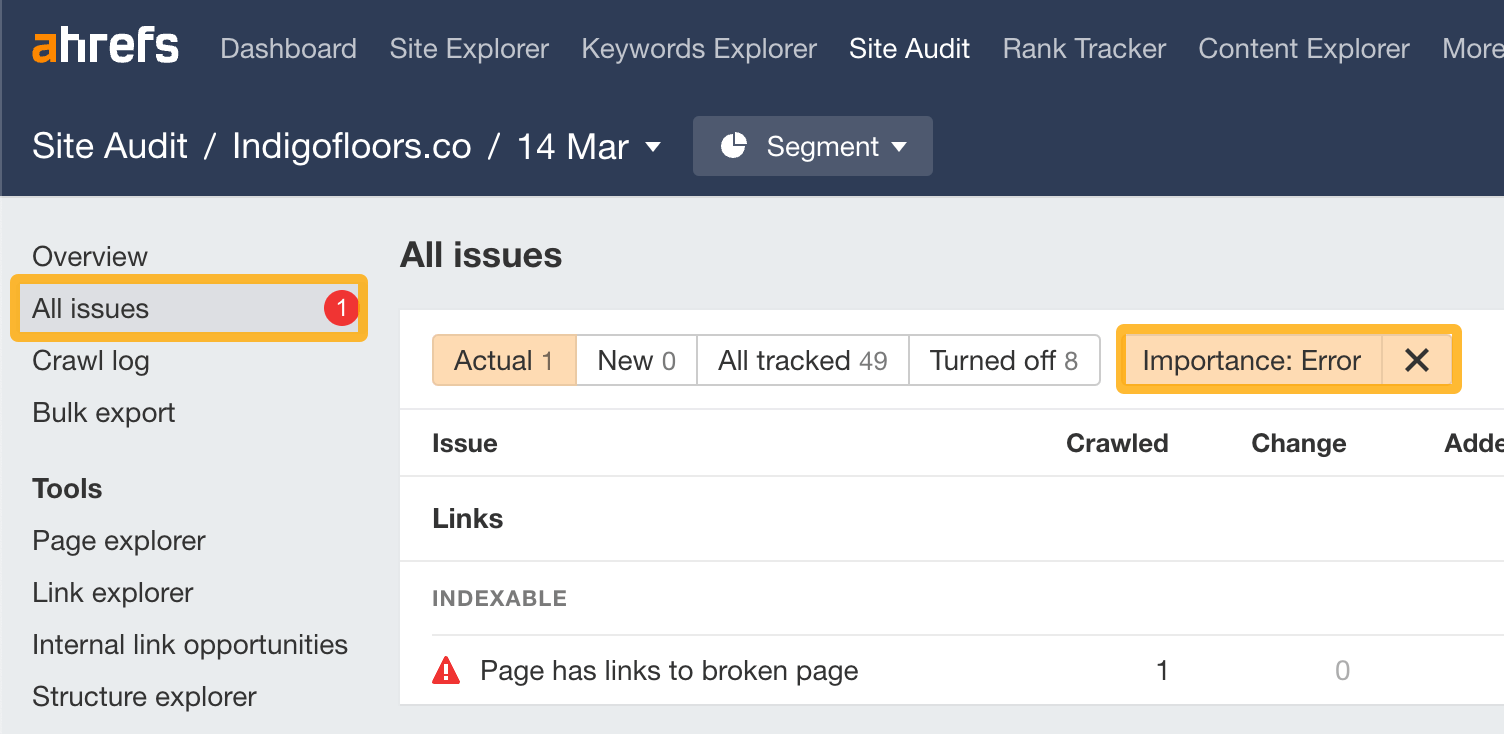

For advice on what the issues mean and how to fix them, hit the tooltip:
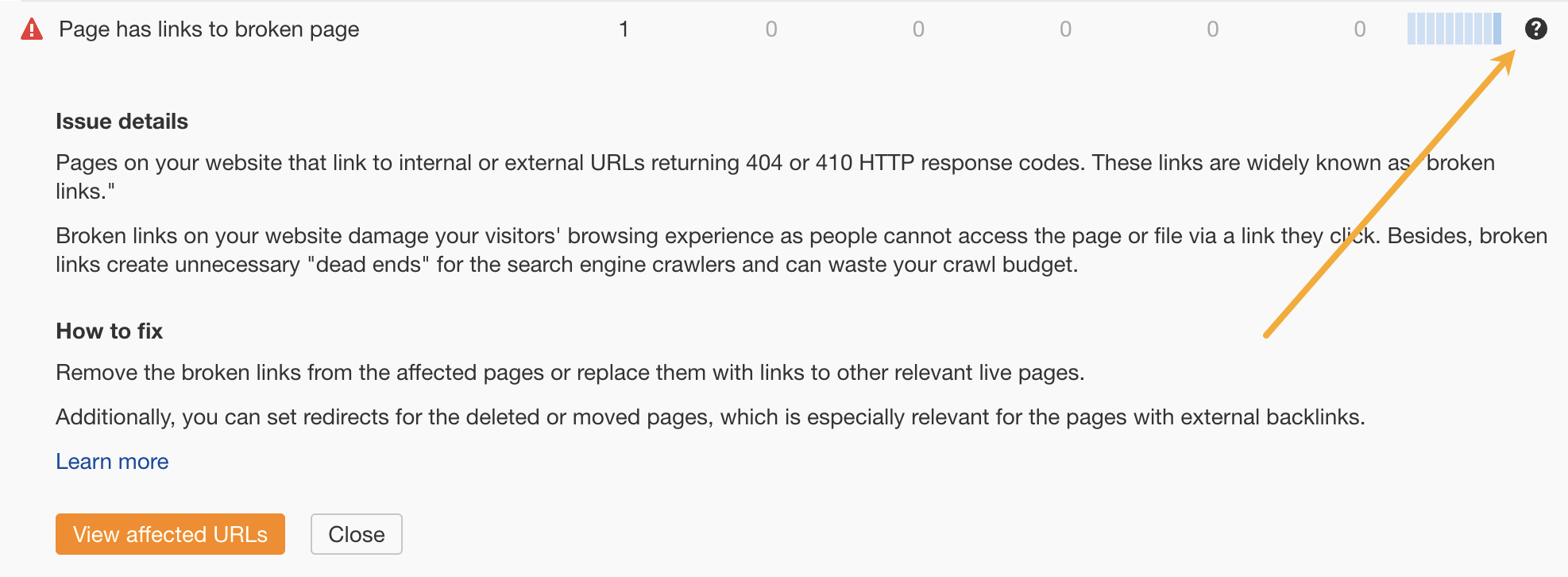

For example, Site Audit found eight 404 pages on our blog during a recent crawl:


To fix this issue, we can either reinstate, redirect, or remove internal links to the pages.
If you also schedule regular crawls in Site Audit, you’ll get alerts about new SEO issues so you can fix them before they cause problems.
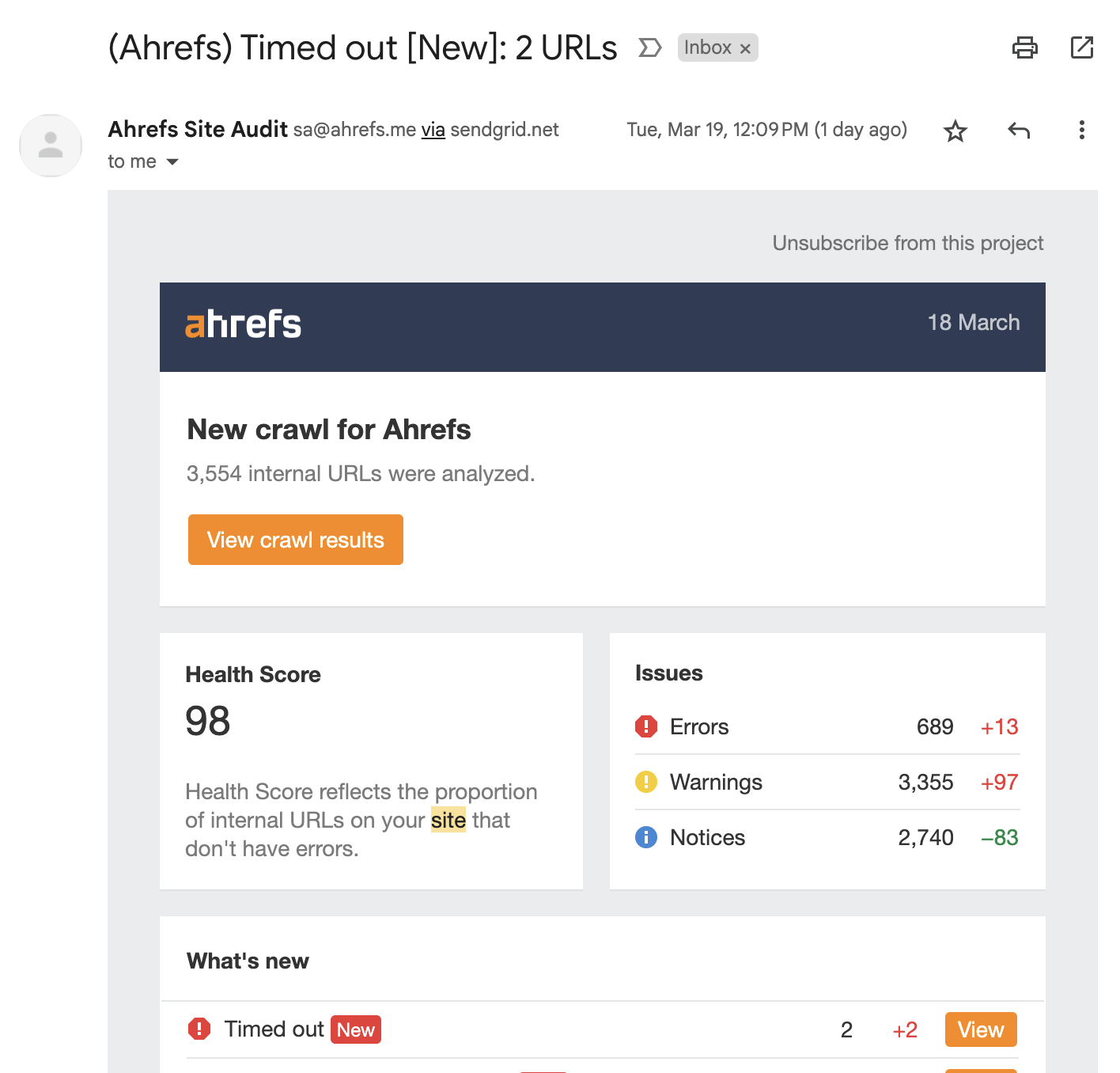

People often search for specific products or services rather than what your business does. For example, they might search for “bathroom remodel near me” instead of “plumber near me.”
If they do this, Google tends to show pages about that service, not plumbers’ homepages.
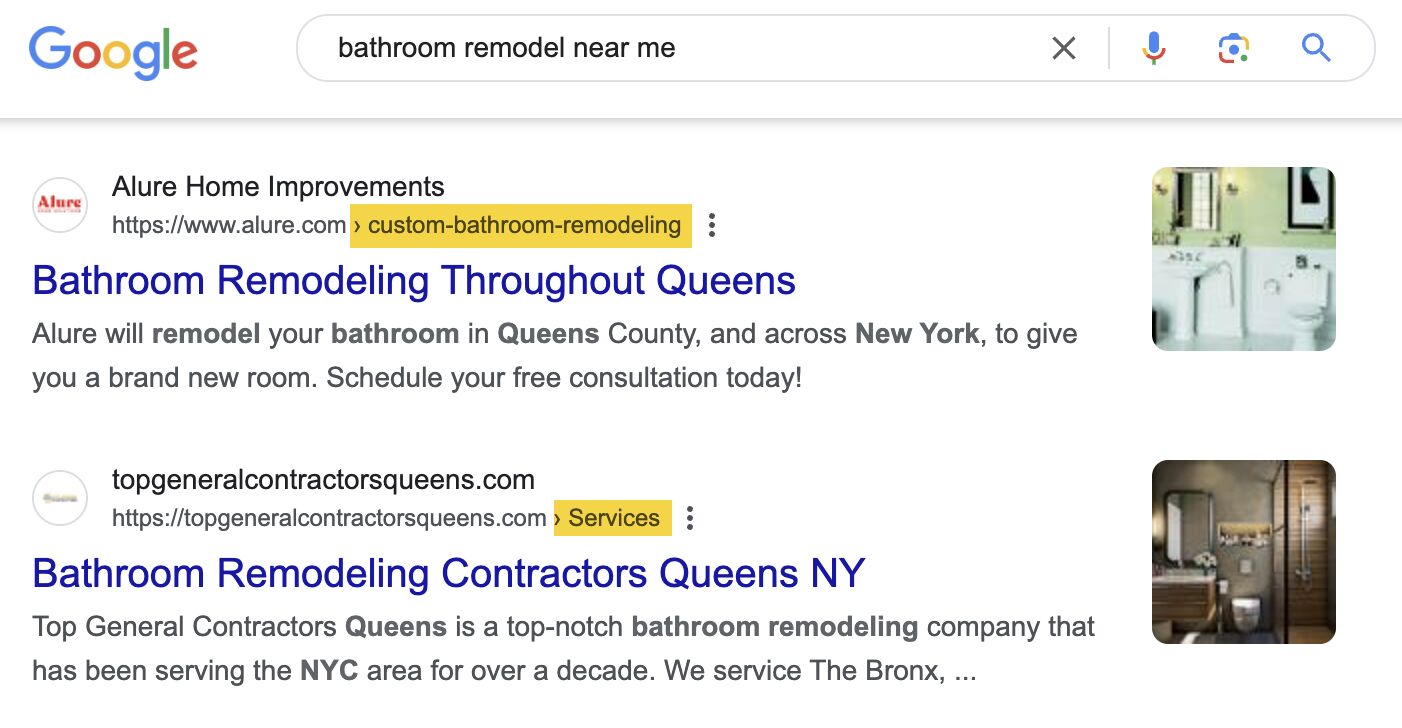

You might struggle to rank for these terms unless you have these pages.
But you might be thinking, “I offer lots of services. I don’t have enough time to create pages for all of them.”
Keyword research is the answer. This is the process of discovering what words and phrases your customers are typing into Google. You can use it to find the products or services they’re searching for the most and then prioritize creating pages about them.
Here’s how to do it:
- Brainstorm all the products or services you offer
- Paste them into Ahrefs’ Keywords Explorer (make sure to select the country you’re in)
You’ll see the keywords sorted by their estimated monthly search volumes from high to low:
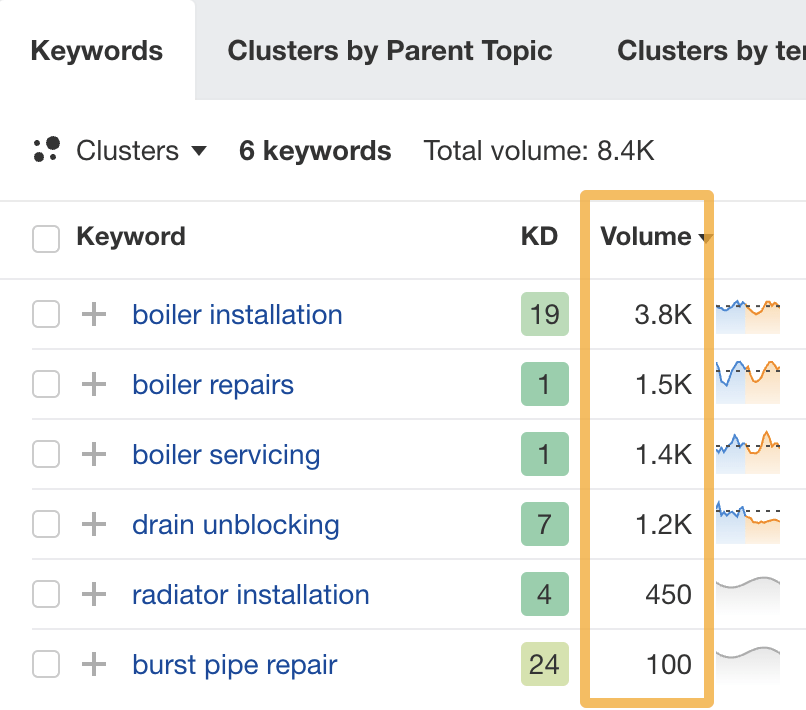

This should give you a good idea of relative interest in the products or services you offer and the pages you should prioritize creating.
Sidenote.
These are national volumes, but that shouldn’t really matter. If a service is more popular than another nationally, it’s probably more popular in the local area where your business operates, too. The only caveat is if you offer something like HVAC services and the climate in your country differs greatly from region to region.
For example, it would make sense to have a page for boiler servicing if it’s something you offer.
Having pages about your products and services is one thing, but you also need to make sure they tell searchers what they want to know. If you know your customers well, you can probably get halfway there easily. But it’s always best to do a bit of research.
For example, I was recently searching for someone to repair our boiler…
My process went a little like this:
- Searched Google for “boiler repair near me”
- Had a quick look at the reviews and websites of the top-ranked businesses
- Called the most promising ones
I knew that our boiler brand isn’t very common, so I was specifically looking for engineers who mentioned working with our brand on their websites. Out of a dozen sites I checked, only one mentioned this:
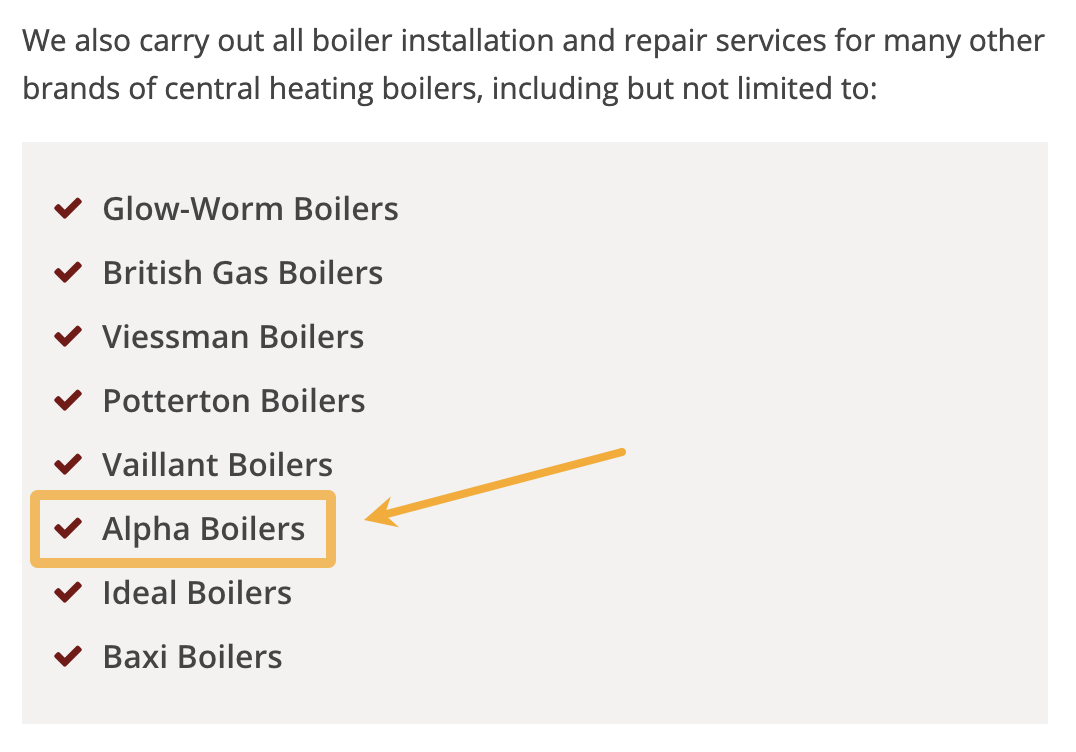

As a result, this was the first company I called.
If the other engineers had only done a bit of keyword research, they’d have known this is something customers care about and included it on their pages.
Here’s how you can do that in Ahrefs:
- Go to Keywords Explorer
- Search for your product or service (e.g., “boiler repair”)
- Go to the Matching Terms report
- Go to the “Cluster by terms” tab
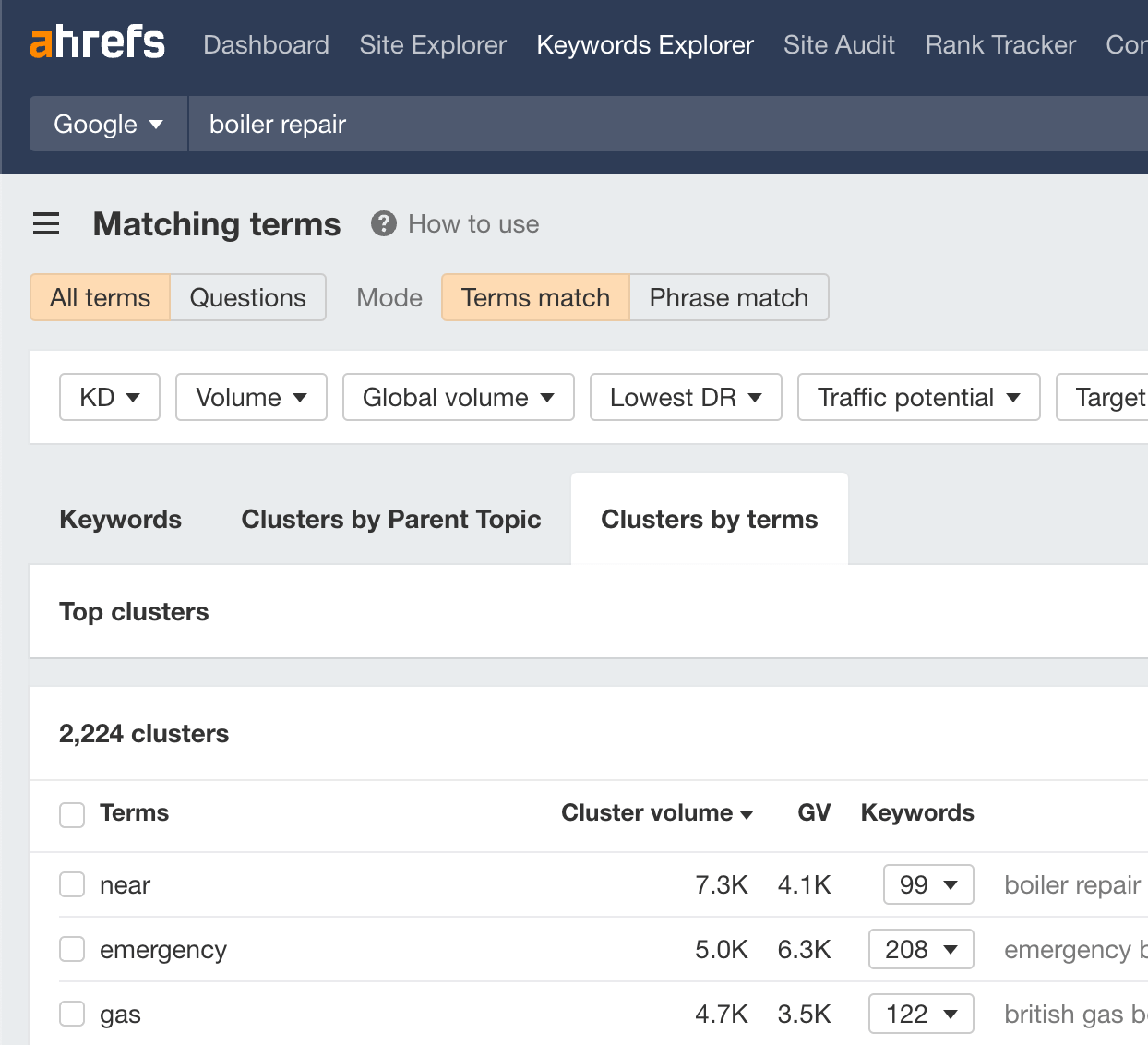

From here, skim the list for similar terms that might indicate the kind of information searchers are looking for.
For example, the highlighted terms below are all boiler brands:
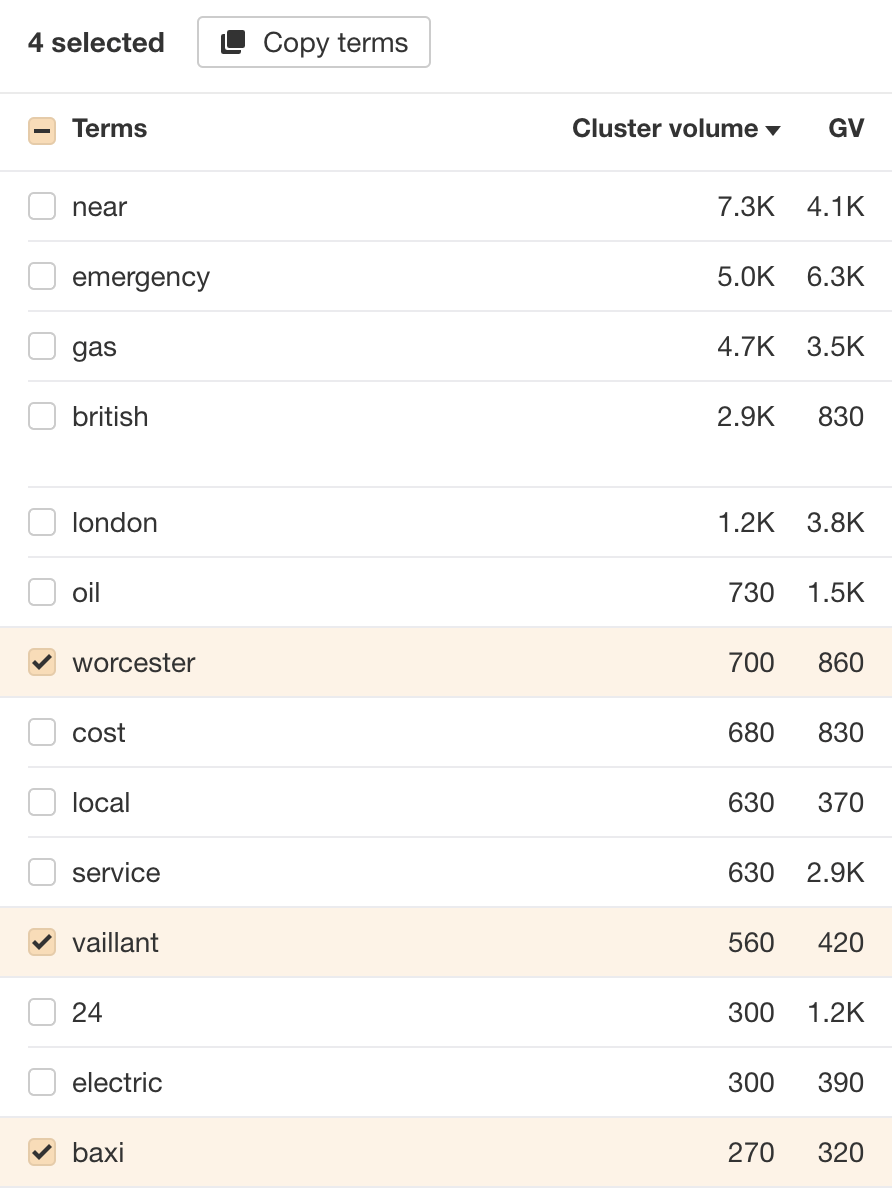

I also see mentions of different types of boilers, like oil, gas, and electric:
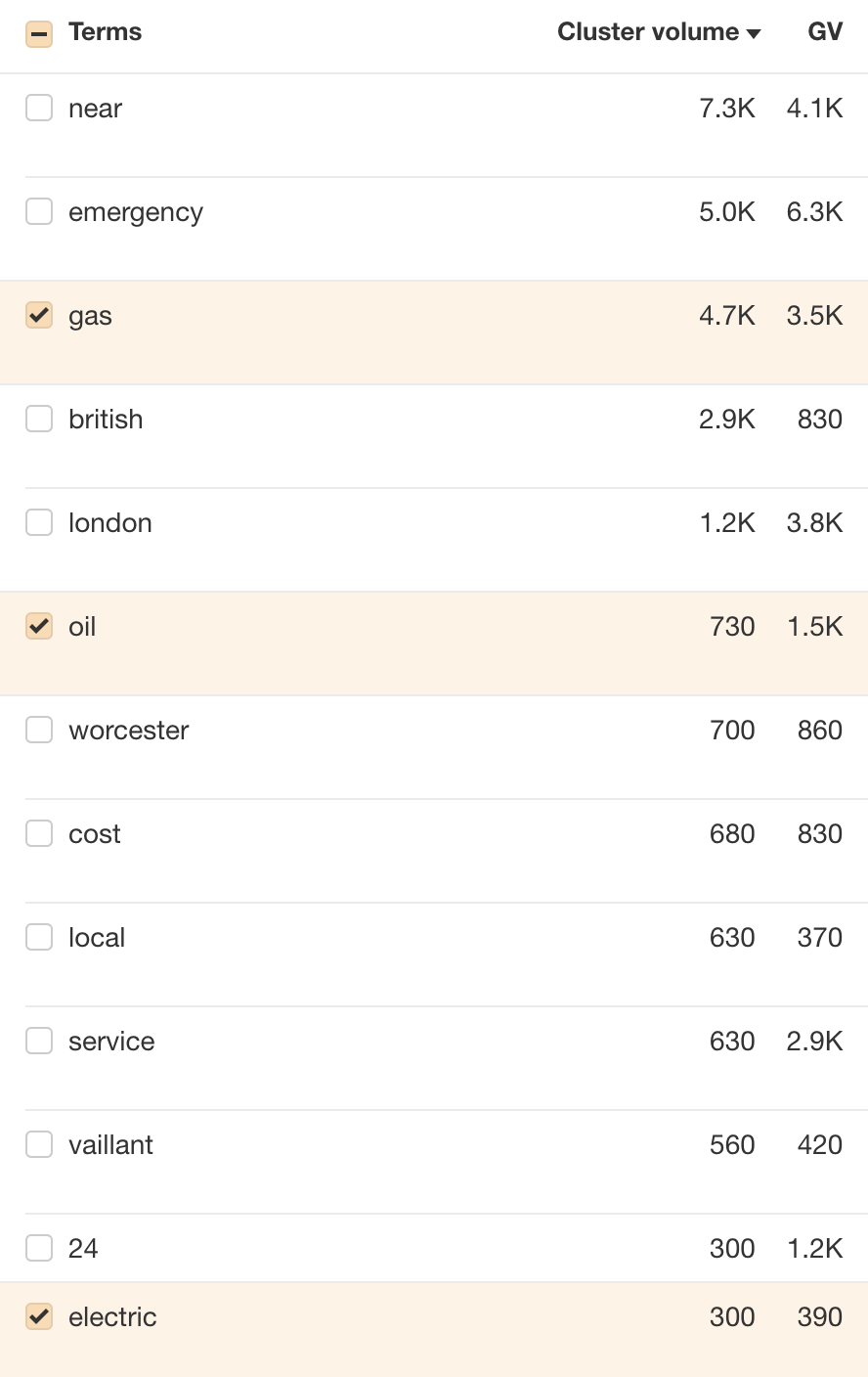

From this quick skim alone, it’s clear that searchers are looking for engineers who can repair their type and brand of boiler.
If you’re a local boiler engineer, having this information not only helps searchers but also saves wasted time answering the phone to give your “Oh… I don’t work with that brand of boiler, sorry!” response.
Can this also help you rank higher?
In all likelihood, yes.
For example, had I searched Google for local engineers who work with our brand of boiler, the engineer’s website that actually mentions the brand ranks in position #3:
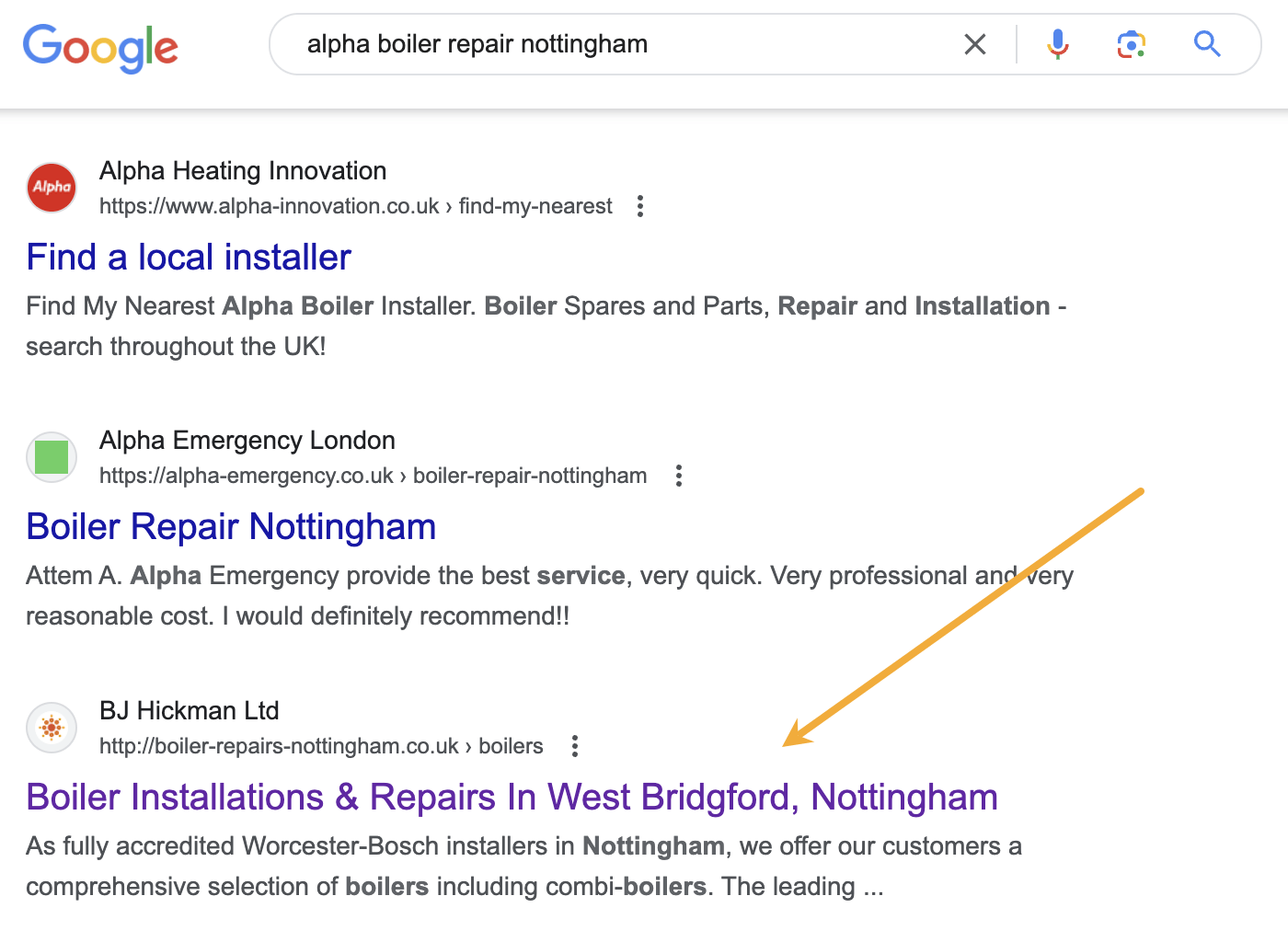

Backlinks are a known ranking factor. The only problem is that high-quality backlinks are far from easy to get. (This is what makes them such a good ranking factor.)
For small businesses, taking advantage of existing relationships is a good starting point.
Here are a few ideas:
- Give suppliers testimonials. These often get featured on their sites along with a link.
- Publish client spotlights. For example, if you’re a plumber who recently helped renovate your local church, write it up and ping them about it. They might feature it on their website.
- Pitch stockist pages. For example, if your store stocks a local craft beer, see if the brewery lists its stockists on its website. If its does, you can usually get featured just by asking.
I would also recommend trying to replicate your competitors’ best backlinks. To find these, plug their site into Ahrefs’ Site Explorer and check the Backlinks report.
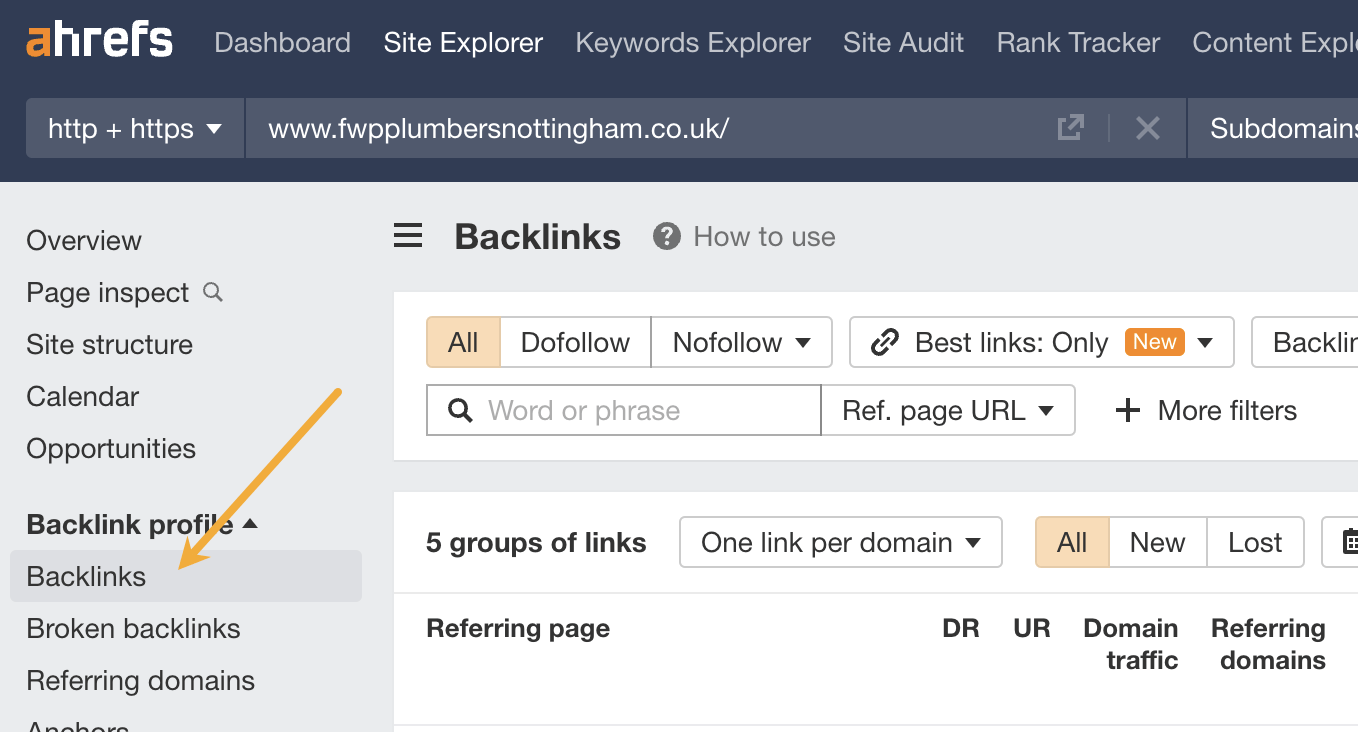

Sidenote.
If there is a lot to go through, toggle the “Best links” filter to narrow things down.
For example, this local plumber has two links from sites listing small businesses that offer discounts to health and other key workers:
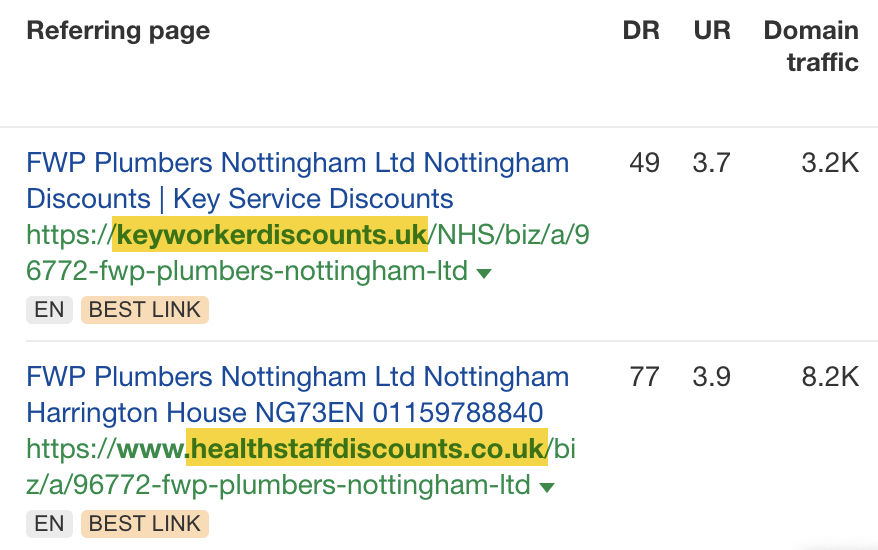

Both of these would be pretty easy links to replicate (assuming you’re happy to offer this discount!)
Google itself advises small business owners to remind customers to leave reviews and reply to them to build trust:
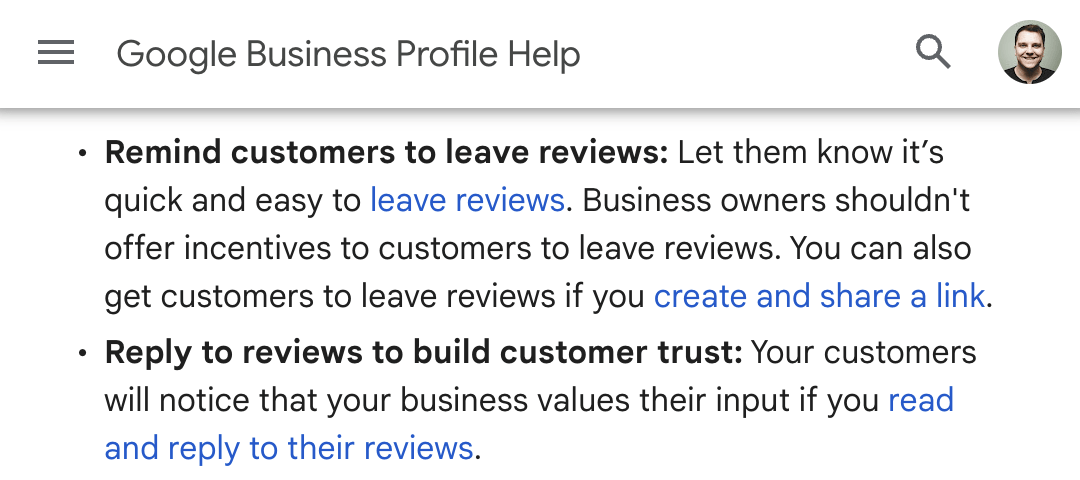

As Google says, the easiest way to do this is to create and share a link to your Business Profile with customers. You can do this in “thank you” emails, at the end of customer support interactions, or simply by including a link or QR code on receipts.
This is also likely to help with your “map pack” rankings, at least according to BrightLocal’s survey. It states that 17% of SEOs deem reviews to be the most important ranking factor.
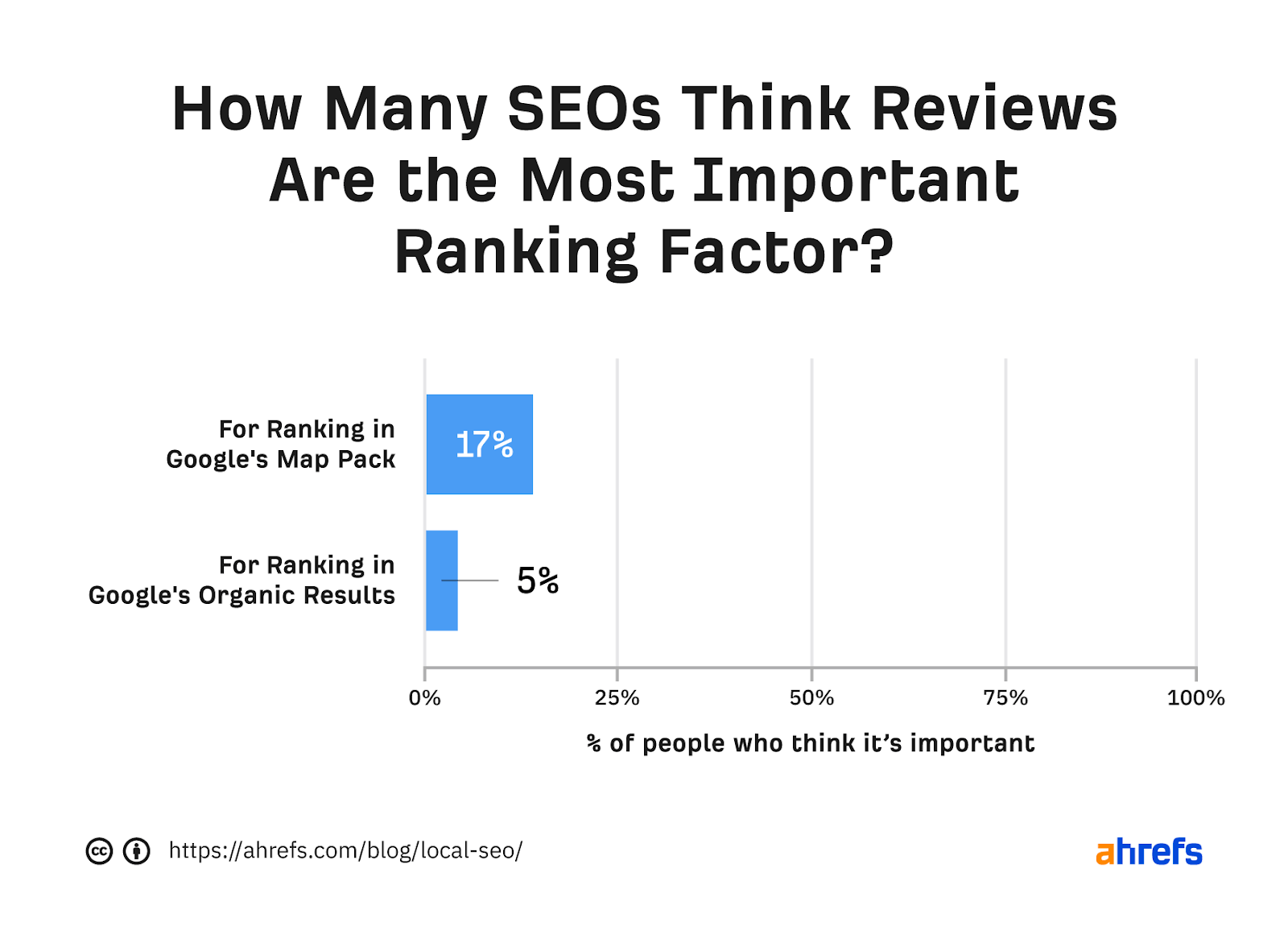

But don’t limit yourself to asking for and replying to reviews on your Google Business Profile. Many customers also trust other websites. If you’re wondering which review sites matter most for your small business, Google its name and look for other review sites in the results.
For example, reviews on TripAdvisor are clearly important for my favorite pizzeria:


For my favorite local craft bottle shop, niche review sites like RateBeer and Untapped seem more important:
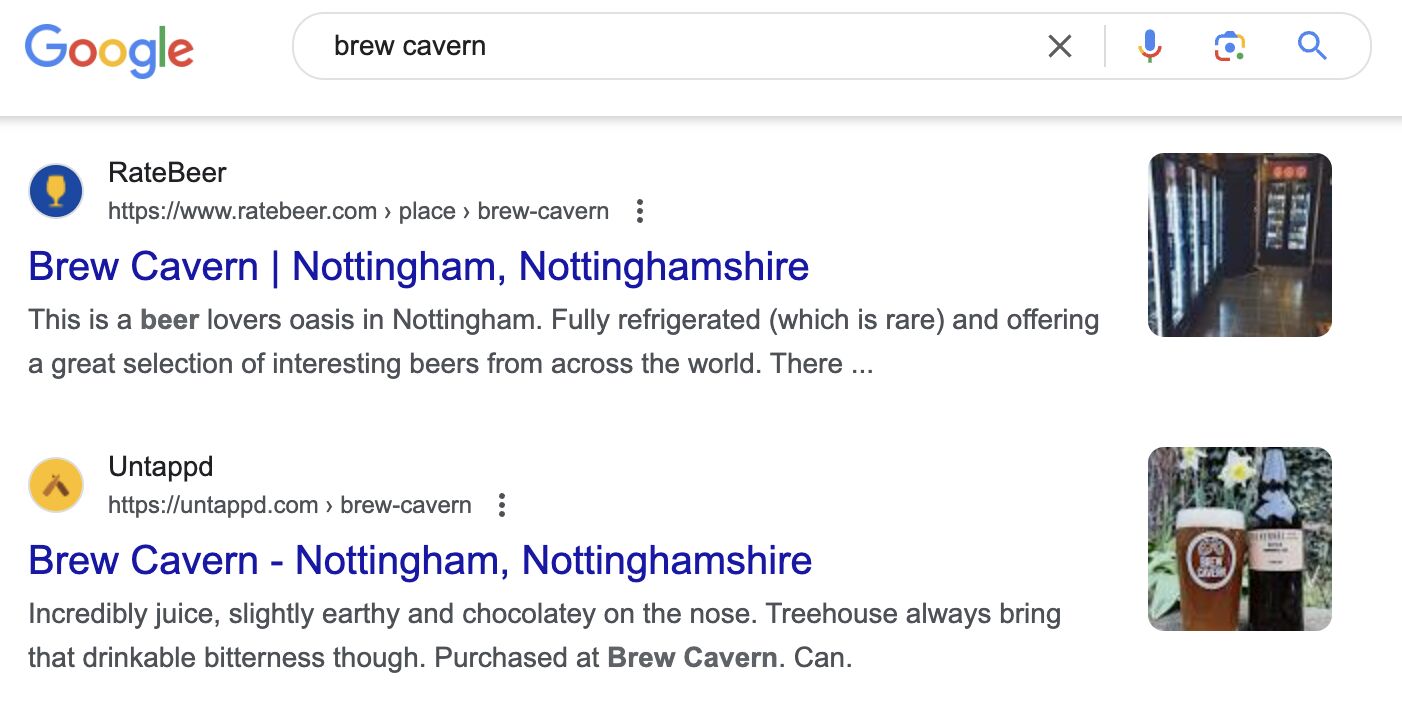

FAQs
What is small business SEO?
Small business SEO is the process of improving your online presence to get more customers from Google and other search engines. It almost always revolves heavily around optimizing for local searches.
What are the benefits of small business SEO?
There are three main benefits of doing SEO for your small business:
- More brand awareness. Showing up in more places online means more people will become familiar with your business.
- More traffic. Ranking higher in Google and other search engines leads to more traffic.
- More customers. As long as your traffic is targeted, it’ll bring in more customers or clients.
What’s the difference between small business SEO and local SEO?
Unless you sell products or services beyond your local area, not much.
If your small business sells products nationally or internationally, check out our guide to ecommerce SEO or our guide to international SEO.
If your small business sells services in multiple locations (e.g., car hire), read our guide to local keyword research to learn how to optimize for that.
SEO
Google March 2024 Core Update Officially Completed A Week Ago

Google has officially completed its March 2024 Core Update, ending over a month of ranking volatility across the web.
However, Google didn’t confirm the rollout’s conclusion on its data anomaly page until April 26—a whole week after the update was completed on April 19.
Many in the SEO community had been speculating for days about whether the turbulent update had wrapped up.
The delayed transparency exemplifies Google’s communication issues with publishers and the need for clarity during core updates
Google March 2024 Core Update Timeline & Status
First announced on March 5, the core algorithm update is complete as of April 19. It took 45 days to complete.
Unlike more routine core refreshes, Google warned this one was more complex.
Google’s documentation reads:
“As this is a complex update, the rollout may take up to a month. It’s likely there will be more fluctuations in rankings than with a regular core update, as different systems get fully updated and reinforce each other.”
The aftershocks were tangible, with some websites reporting losses of over 60% of their organic search traffic, according to data from industry observers.
The ripple effects also led to the deindexing of hundreds of sites that were allegedly violating Google’s guidelines.
Addressing Manipulation Attempts
In its official guidance, Google highlighted the criteria it looks for when targeting link spam and manipulation attempts:
- Creating “low-value content” purely to garner manipulative links and inflate rankings.
- Links intended to boost sites’ rankings artificially, including manipulative outgoing links.
- The “repurposing” of expired domains with radically different content to game search visibility.
The updated guidelines warn:
“Any links that are intended to manipulate rankings in Google Search results may be considered link spam. This includes any behavior that manipulates links to your site or outgoing links from your site.”
John Mueller, a Search Advocate at Google, responded to the turbulence by advising publishers not to make rash changes while the core update was ongoing.
However, he suggested sites could proactively fix issues like unnatural paid links.
“If you have noticed things that are worth improving on your site, I’d go ahead and get things done. The idea is not to make changes just for search engines, right? Your users will be happy if you can make things better even if search engines haven’t updated their view of your site yet.”
Emphasizing Quality Over Links
The core update made notable changes to how Google ranks websites.
Most significantly, Google reduced the importance of links in determining a website’s ranking.
In contrast to the description of links as “an important factor in determining relevancy,” Google’s updated spam policies stripped away the “important” designation, simply calling links “a factor.”
This change aligns with Google’s Gary Illyes’ statements that links aren’t among the top three most influential ranking signals.
Instead, Google is giving more weight to quality, credibility, and substantive content.
Consequently, long-running campaigns favoring low-quality link acquisition and keyword optimizations have been demoted.
With the update complete, SEOs and publishers are left to audit their strategies and websites to ensure alignment with Google’s new perspective on ranking.
Core Update Feedback
Google has opened a ranking feedback form related to this core update.
You can use this form until May 31 to provide feedback to Google’s Search team about any issues noticed after the core update.
While the feedback provided won’t be used to make changes for specific queries or websites, Google says it may help inform general improvements to its search ranking systems for future updates.
Google also updated its help documentation on “Debugging drops in Google Search traffic” to help people understand ranking changes after a core update.
Featured Image: Rohit-Tripathi/Shutterstock
FAQ
After the update, what steps should websites take to align with Google’s new ranking criteria?
After Google’s March 2024 Core Update, websites should:
- Improve the quality, trustworthiness, and depth of their website content.
- Stop heavily focusing on getting as many links as possible and prioritize relevant, high-quality links instead.
- Fix any shady or spam-like SEO tactics on their sites.
- Carefully review their SEO strategies to ensure they follow Google’s new guidelines.
SEO
Google Declares It The “Gemini Era” As Revenue Grows 15%

Alphabet Inc., Google’s parent company, announced its first quarter 2024 financial results today.
While Google reported double-digit growth in key revenue areas, the focus was on its AI developments, dubbed the “Gemini era” by CEO Sundar Pichai.
The Numbers: 15% Revenue Growth, Operating Margins Expand
Alphabet reported Q1 revenues of $80.5 billion, a 15% increase year-over-year, exceeding Wall Street’s projections.
Net income was $23.7 billion, with diluted earnings per share of $1.89. Operating margins expanded to 32%, up from 25% in the prior year.
Ruth Porat, Alphabet’s President and CFO, stated:
“Our strong financial results reflect revenue strength across the company and ongoing efforts to durably reengineer our cost base.”
Google’s core advertising units, such as Search and YouTube, drove growth. Google advertising revenues hit $61.7 billion for the quarter.
The Cloud division also maintained momentum, with revenues of $9.6 billion, up 28% year-over-year.
Pichai highlighted that YouTube and Cloud are expected to exit 2024 at a combined $100 billion annual revenue run rate.
Generative AI Integration in Search
Google experimented with AI-powered features in Search Labs before recently introducing AI overviews into the main search results page.
Regarding the gradual rollout, Pichai states:
“We are being measured in how we do this, focusing on areas where gen AI can improve the Search experience, while also prioritizing traffic to websites and merchants.”
Pichai reports that Google’s generative AI features have answered over a billion queries already:
“We’ve already served billions of queries with our generative AI features. It’s enabling people to access new information, to ask questions in new ways, and to ask more complex questions.”
Google reports increased Search usage and user satisfaction among those interacting with the new AI overview results.
The company also highlighted its “Circle to Search” feature on Android, which allows users to circle objects on their screen or in videos to get instant AI-powered answers via Google Lens.
Reorganizing For The “Gemini Era”
As part of the AI roadmap, Alphabet is consolidating all teams building AI models under the Google DeepMind umbrella.
Pichai revealed that, through hardware and software improvements, the company has reduced machine costs associated with its generative AI search results by 80% over the past year.
He states:
“Our data centers are some of the most high-performing, secure, reliable and efficient in the world. We’ve developed new AI models and algorithms that are more than one hundred times more efficient than they were 18 months ago.
How Will Google Make Money With AI?
Alphabet sees opportunities to monetize AI through its advertising products, Cloud offerings, and subscription services.
Google is integrating Gemini into ad products like Performance Max. The company’s Cloud division is bringing “the best of Google AI” to enterprise customers worldwide.
Google One, the company’s subscription service, surpassed 100 million paid subscribers in Q1 and introduced a new premium plan featuring advanced generative AI capabilities powered by Gemini models.
Future Outlook
Pichai outlined six key advantages positioning Alphabet to lead the “next wave of AI innovation”:
- Research leadership in AI breakthroughs like the multimodal Gemini model
- Robust AI infrastructure and custom TPU chips
- Integrating generative AI into Search to enhance the user experience
- A global product footprint reaching billions
- Streamlined teams and improved execution velocity
- Multiple revenue streams to monetize AI through advertising and cloud
With upcoming events like Google I/O and Google Marketing Live, the company is expected to share further updates on its AI initiatives and product roadmap.
Featured Image: Sergei Elagin/Shutterstock
SEO
brightonSEO Live Blog
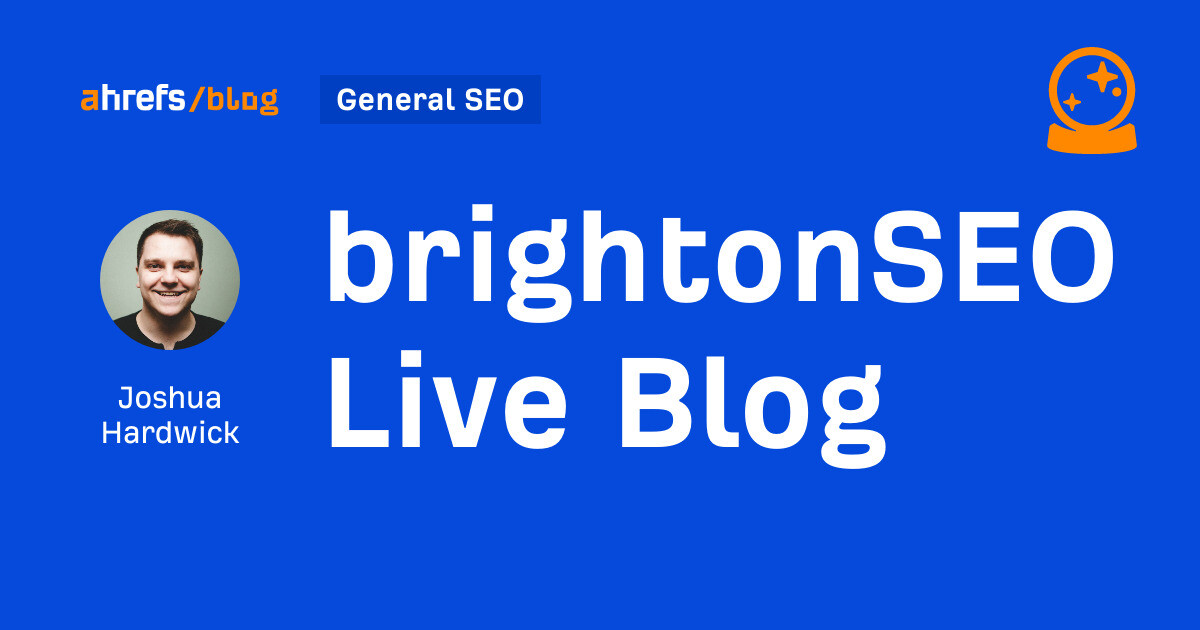
Hello everyone. It’s April again, so I’m back in Brighton for another two days of Being the introvert I am, my idea of fun isn’t hanging around our booth all day explaining we’ve run out of t-shirts (seriously, you need to be fast if you want swag!). So I decided to do something useful and live-blog the event instead.
Follow below for talk takeaways and (very) mildly humorous commentary. sun, sea, and SEO!
-
SEARCHENGINES7 days ago
Daily Search Forum Recap: April 19, 2024
-

 WORDPRESS7 days ago
WORDPRESS7 days ago7 Best WooCommerce Points and Rewards Plugins (Free & Paid)
-

 MARKETING7 days ago
MARKETING7 days agoBattling for Attention in the 2024 Election Year Media Frenzy
-

 WORDPRESS6 days ago
WORDPRESS6 days ago13 Best HubSpot Alternatives for 2024 (Free + Paid)
-

 MARKETING6 days ago
MARKETING6 days agoAdvertising in local markets: A playbook for success
-

 SEO7 days ago
SEO7 days agoGoogle Answers Whether Having Two Sites Affects Rankings
-

 SEARCHENGINES6 days ago
SEARCHENGINES6 days agoGoogle Core Update Flux, AdSense Ad Intent, California Link Tax & More
-

 AFFILIATE MARKETING7 days ago
AFFILIATE MARKETING7 days agoGrab Microsoft Project Professional 2021 for $20 During This Flash Sale




![The Current State of Google’s Search Generative Experience [What It Means for SEO in 2024] person typing on laptop with](https://articles.entireweb.com/wp-content/uploads/2024/04/The-Current-State-of-Googles-Search-Generative-Experience-What-It.webp-400x240.webp)
![The Current State of Google’s Search Generative Experience [What It Means for SEO in 2024] person typing on laptop with](https://articles.entireweb.com/wp-content/uploads/2024/04/The-Current-State-of-Googles-Search-Generative-Experience-What-It.webp-80x80.webp)









